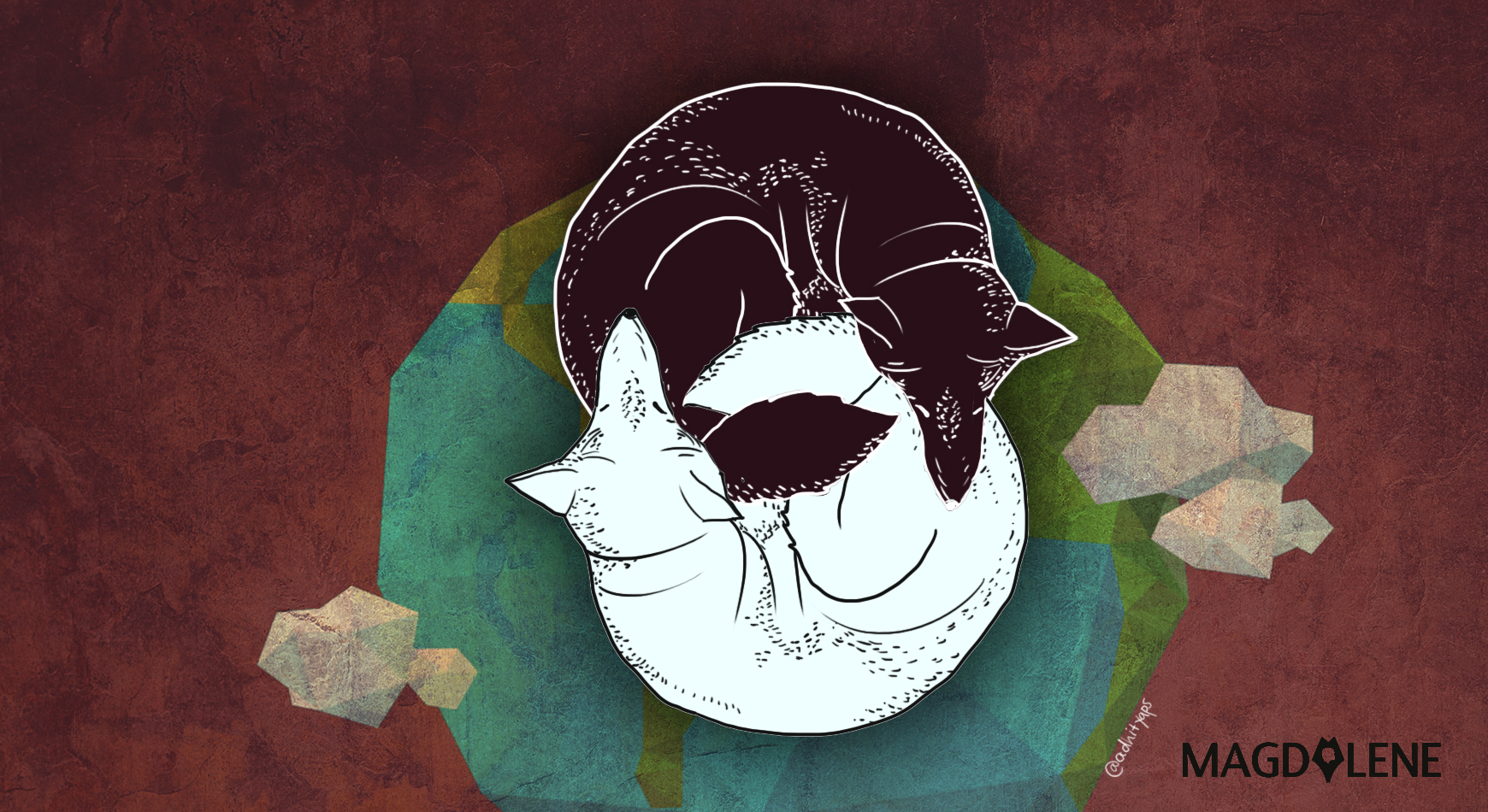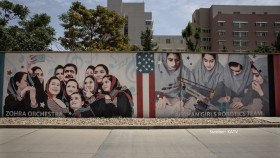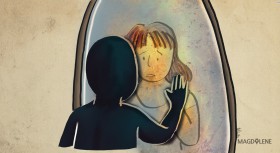I got the chance to get to know the lives of the Chinese community in Tangerang when I was assigned to do an etnographic research last term—and it was a very enriching and eye-opening experience.
I’ve been living in Depok for the past five years ago when I started my undergraduate study, but the trip a few months back was my very first visit to Tangerang. At the city gateway, we were welcomed with the slogan: “Tangerang Kota ‘Akhlaqul Karimah’”, an Arabic phrase that means “praiseworthy character”. At a glance, this suggest a homogenously Islamic society – thankfully, it isn’t.
My classmates and I went on a day tour to understand the historical background of the Chinese community’s existence in Tangerang. First, we went to the oldest temple in Tangerang named Boen Tek Bio. Located near the Pasar Baru market, it was built in 1684, evidence that the Chinese community had been living there even before the Dutch came.
 We also looked at nearby residential buildings that still maintain Chinese architecture, as identified by the shape of its unique roof style. There is also the historical Kalipasir Mosque which was established around the 17th centuries and is crowned with Buddhist style golden dome. The mosque was originally built by the local Muslim community with the help of the Chinese community, hence the hybrid architecture.
We also looked at nearby residential buildings that still maintain Chinese architecture, as identified by the shape of its unique roof style. There is also the historical Kalipasir Mosque which was established around the 17th centuries and is crowned with Buddhist style golden dome. The mosque was originally built by the local Muslim community with the help of the Chinese community, hence the hybrid architecture.
We walked along the Cisadane river, where the annual dragon boat competition is held. Our guide, academician and local activist Koh Ahcong, told us the story behind the dragon boat. Historically, the dragon boat race was held to commemorate the death of Qu Yuan, a patriotic and dedicated King advisor, the most trusted one in the Kingdom of Chu. Legend has it that he was advising the King to make allies and fight against the powerful State of Qin, but before it was accomplished, he fell victim to jealous officials who accused him of treason. As a result, Qu Yuan was sent to exile. As he was also a poet, Qu Yuan wrote influential poems during the difficult times to express his love and loyalty for his country. Most of the poems are well-known up to this day. Later, when Qu Yuan heard about the defeat of the Kingdom of Chu by the State of Qin, he was in total despair that he eventually drowned himself in Miluo river on the fifth day of the fifth lunar month.
According to the legend, local people were very upset of Qu Yuan’s death. They rowed their boats on the river to search for his body, but never found it. To scare away evil spirits, they beat the drums while searching the body . They also threw lumps of rice into the river so that the fish would not eat Qu Yuan’s body.
In Cisadane river, the dragon boat festival has not only attended by the Chinese community, but also by local people.
“Whoever want to participate in the event join,” Said Koh Achong, “and that’s also one of the ways the relationship between the Chinese community and the local Indonesian people were built here.”
During Soeharto’s New Order regime, the government systematically restricted the social role of the Chinese community in Indonesia. As a result, the dragon boat annual festival, which had been going for centuries, was banned. Fortunately, when the late President Abdurrahman Wahid became president, he lifted the ban and revived the tradition in his effort to mend relationship with the Chinese community. Thanks to him, now we can watch and even participate in the festival.
Chinese Community in Boen San Bio
Boen San Bio is the second oldest kelenteng or Chinese temple in Tangerang. When the New Order regime prohibited the use of Chinese names and the display of Chinese letters, Boen San Bio was renamed Vihara Nimmala. It was built back in 1689 by a Chinese merchant named Lim Tau Koen. Since it was established, the temple has gone through numerous renovation that resulted in its current marvelous design.

During my visits I was accompanied by one of the temple managers, Manto Dermawan. He explained that every temple has a host, and that the host of Boen San Bio temple is Hok Tek Tjeng Sin, the Earth God. He also told me about the basic principle of Chinese philosophy.
“In the concept of tridharma we acknowledged the three teachings of Chinese philosophy, which are: Confucianism, Taoism, and Buddhism. Followers of all these three can pray in Boen San Bio,” Manto explained.
Interestingly, the temple has a worship place called Petilasan Surya Kentjana where members of the local Muslim community pay a visit and pray.
“Surya Kentjana was an influential figure back then. Therefore, the petilasan was built by the Chinese community to pay respect to him and the belief of the local people. To this day, during Idul Fitri and Idul Adha local Muslim community usually come to pray and gather in the place,” said Manto.
 Petilasan Surya Kentjana is located inside the Chinese temple in its backyard. Painted green and yellow on the outside, its interior is designed like a small cave. Inside the room, there are two beds side by side that are meant to be the beds of Surya Kentjana and his wife. At each side of the beds, there are praying gears such as prayer robe and rug and a Quran.
Petilasan Surya Kentjana is located inside the Chinese temple in its backyard. Painted green and yellow on the outside, its interior is designed like a small cave. Inside the room, there are two beds side by side that are meant to be the beds of Surya Kentjana and his wife. At each side of the beds, there are praying gears such as prayer robe and rug and a Quran.
On the veranda sits a worship altar where the Chinese community can also burn an incense and pray to Surya Kentjana.
Once a week, the Buddhist community gather to recite verses and scriptures to ward off evil fortune at a big hall called Dhamassala in the complex often used for special occasion as well. One of the Buddhist community members I met, Vonny (62), has been regular visitor of the temple.
“I always pray in Boen San Bio with my husband. I also attend the weekly activity in Dhamassala since I was young. All of my children are also members here. My grandchildren have also been students in Boen San Bio Sunday school,” she said.
Another worshiper Atma (48), a housewife, said she was new to the place as well as the religion.
“I grew up in Lampung before I moved to Tangerang. My first religion was Catholic, but then I entered Christian Primary School and so I became a Christian. Growing older, I converted to Islam. I recited the ‘syahadat’, prayed five times a day and everything. Unfortunately, I still didn’t feel comfortable enough. So, when I was a young adult, I tried Buddhism, and I am a Buddhist to this day. My husband is also a Buddhist,” she said.
Having changed religion several times, Atma also frees her children to choose their own.
“When my children were teenagers, they chose to be Christians. I guess they feel that the Christian church looks more prestigious – the way kids that age would think. Maybe sitting comfortably in a room with air-con feels better compared to the ‘out of date’ Buddhism where the people pray on the floor. But when they entered college, both decided to become Buddhists again,” she added.
When I asked what made her finally feel comfortable being a Buddhist, and why she let her children choose their religion freely, she told me there is no one-size-fits-all religion. Every person can decide on what feels right for themselves and what is not, she said.
“What is different about Buddhism for me, personally, compared to other religions that I’ve tried, is the concept of afterlife. Catholic, Christian, and Islam have the concept of heaven and hell, while Buddhism has karma and nirvana. It is simple for me, personally. Karma, you did bad deeds, you reap bad things; you did good deeds, you reap good things, and then you reach nirvana as the highest point of enlightenment,” she explains.
“I believe that religion should be chosen independently by every individual, not just because they have to follow the mainstream population. I believe that the main purpose of religion itself is to be learned and studied,” Atma added.
 Another member, Hoan (64) told me a different experience with relatives of different religion.
Another member, Hoan (64) told me a different experience with relatives of different religion.
“Honestly, I give freedom to my children to choose their religion. My daughter married a Muslim man, so she converted to Islam. However, one day when there was a funeral of my son in-law’s relative, I prayed to the food being provided so that it will be blessed. But one of his relatives refused to touch the rice. The relative said, ‘I don’t want to eat it, it was being prayed by a satan’. I had a genuine good intention, but it wasn’t understood. Therefore, for me personally, all religions are good as long as you’re not a fanatic,” he told.
Hoan explains that he has an open mind looking at other religions, but sometimes, he also has his worries.
One can choose to stick to their family tradition, one can individually make personal choices and let others do the same. No one ideal value fits everybody. To live peacefully in diverse Indonesia, we should accept, appreciate and embrace differences, and never let differences segregates us from other people, and cause us to blindly hate those who are not like us.
My visit to the Buddhist temples and learning about their values is a very eye-opening experience. All the people I met along were very warmhearted and although I was practically a stranger to them, I felt welcome all the way.
Find out what the Quran says about LGBT.







Comments